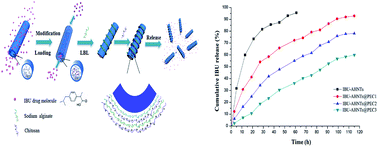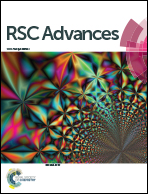The combination of adsorption by functionalized halloysite nanotubes and encapsulation by polyelectrolyte coatings for sustained drug delivery
Abstract
A novel organic–inorganic hybrid nanocomposite was established for the sustained release of an analgesic. Adsorption by functionalized halloysite nanotubes (HNTs) and encapsulation by polyelectrolyte coatings (PECs) via the layer-by-layer (LBL) self-assembly of chitosan (CHI) and sodium alginate (ALG) were combined for the proposed drug delivery. In order to increase loading capacity, HNT lumen enlargement and γ-aminopropyltriethoxysilane (APTES) modification were introduced to manufacture nanocontainers denoted as AHNTs. Ibuprofen (C13H18O2, IBU) is an active analgesic that was selected as a model drug to evaluate the pharmaceutical properties. Fourier transform infrared spectroscopy, transmission electron microscopy, thermal gravimetric analysis, zeta potential, and high-performance liquid chromatography were performed to characterize the structure and properties of ALG/CHI PECs on AHNTs loaded with IBU (IBU-AHNTs@PECs). The release behavior was investigated by changing the PEC and pH conditions. An enhanced capacity for adsorption (32%) and a sustained-release performance (115 h) of IBU-AHNTs@PECs toward IBU were demonstrated, which followed the power law kinetic model. The proposed combination is expected to provide an important strategy to regulate drug delivery and extend pharmaceutical applications.


 Please wait while we load your content...
Please wait while we load your content...